More about: Snorkeling in Fuerteventura
The eight Canary Islands are a great place for snorkelling and other water sports (don't leave the island without trying some surfing lessons). However, Fuerteventura in particular, the oldest island in the Canary archipelago and the one with the most geological interest among professionals, is the perfect place to practice this sport.
Read on and I'll show you the best snorkelling experiences on the island of Fuerteventura, as well as everything you need to know about snorkelling and some tips to help you admire the incredible depths of the ocean. Are you ready?
1. Snorkelling in Costa Calma
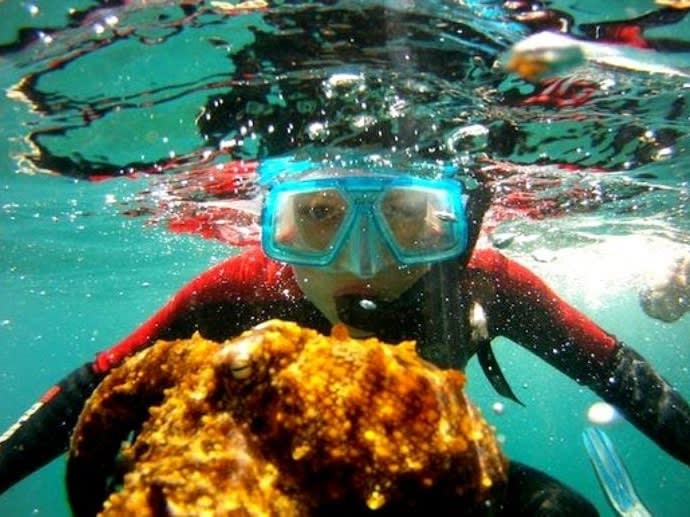
Many beginners consider this beach to be the best place to start snorkelling, as there are plenty of companies here that rent the necessary equipment and offer courses with an instructor.
Costa Calma beach is about 2 kilometres long and is located next to the town of the same name. Here it is easy to come across starfish, turtles and parrot fish.
In addition to its crystal clear, shallow waters, this beach has a lifeguard service, which also makes it an ideal place for snorkelling with children.
2. Snorkel with rays and sea turtles at Lobos Island
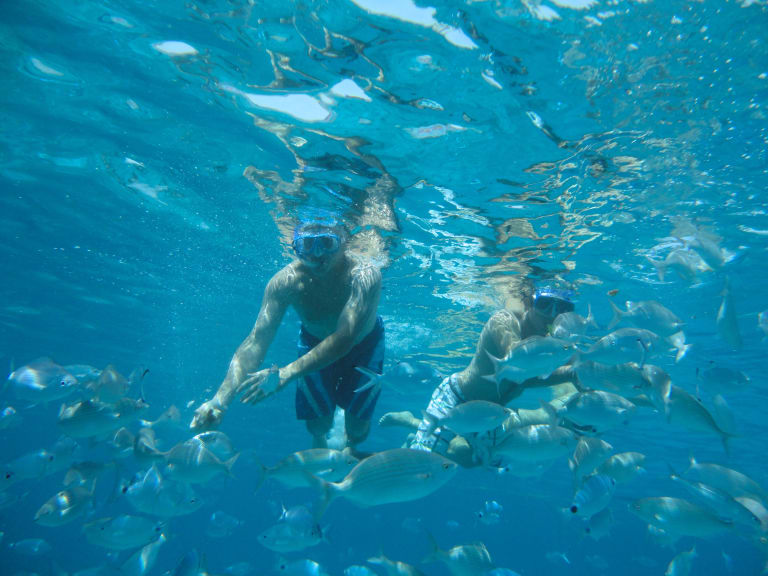
Isla de Lobos, or rather the "islet", is located at the northern tip of Fuerteventura, about 15 minutes by boat from the dock of El Corralejo. Boats leave from there from time to time to transfer passengers, although, if you prefer to arrive at your own pace and without worrying about timetables, you always have the option of taking a water taxi.
Anywhere on this island is ideal for snorkelling, as the waters are very clear and generally shallow. There are also rich marine habitats and palaeontological sites (with an abundance of marine fossils). This is the natural home of stingrays and sea turtles, which, if you're lucky, you'll be able to admire as they roam freely.
By the way, no, although the name of this island may be misleading, you won't find sea lions (also known as monk seals) here. The island is named after a colony that used to live here quite a few years ago, but, unfortunately, man's actions have meant that it no longer exists.
To get here, you'll need to take a ferry or hire a tour.
3. Snorkel at your own pace on the beaches of Isla de Lobos
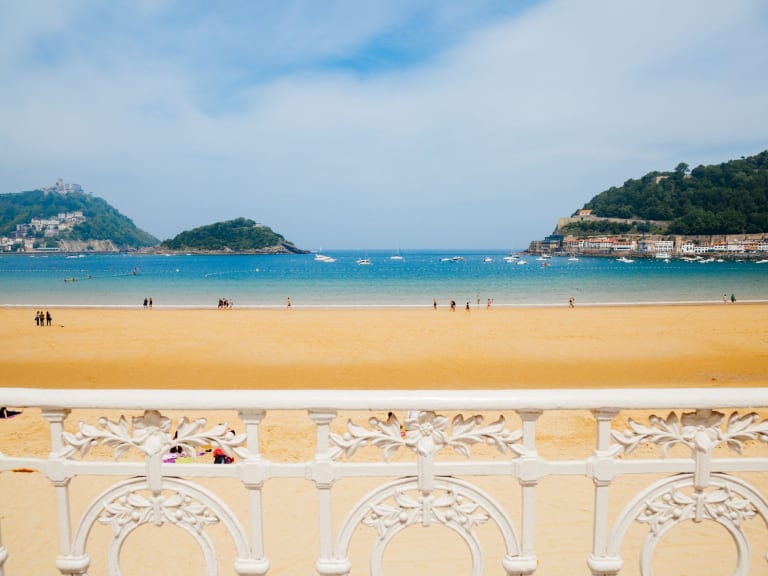
If you liked Isla de Lobos, but prefer to snorkel on your own at one of its beaches, the best ones are Puertito de Lobos beach and La Concha beach, one of the most famous on the island.
Puertito de Lobos beach is great for beginners or people with little experience, as it is a quiet natural pool. But don't worry, there is plenty of marine life here too.
Don't forget that Lobos Island is a protected natural park, so you need a special permit to enter (you can apply for it completely free of charge on their official website).
Remember to bring your own goggles and snorkel, as you won't find any companies on Lobos Island where you can rent them.
If you prefer not to complicate your life, you can hire a boat trip to Lobos Island with one of the companies that organise it. They will arrange the permit for you and also take out the compulsory travel insurance so that you don't have to do anything.
Normally, the timetables governing the Isla de Lobos are not so strictly applied to the boats belonging to the excursion agencies. So, if you go with one, they will probably let you stay a little longer on the island than if you go on your own. I'll leave it at that...
4. Dive between schools of fish in Corralejo

The beaches of Corralejo, which form part of the impressive Corralejo Natural Park, are another favourite spot for snorkellers. Moreover, you can get here without the need to take a boat or ask for a permit, which makes it a much easier option.
I recommend that you don't stay on the best-known beaches, the ones next to the town and where there are plenty of tourists, but that you go a little further out. Corralejo has a few kilometres of coves, so take a walk and wander around: it won't be difficult to find a quiet spot (such as Playa Larga or Playa del Moro).
However, if you haven't brought a snorkel and goggles or it's your first time and you want to learn with the peace of mind of an instructor, head to the town of Corralejo, where you'll find several companies that offer these services, as well as specialising in providing the best surfing experiences and other water sports, such as windsurfing.
5. Snorkel on authentic unspoilt beaches

For many, the beaches in the south of Fuerteventura are the best on the island. Being further away from the larger population centres, they do not have the same services as other places in the north. However, this makes them much wilder and, in some cases, almost virgin enclaves.
If you're an experienced snorkeller looking for a bit of peace and quiet and a bit of a break from the tourists, the southern beaches will certainly not disappoint.
Cofete Beach
It is located on the Jandía Peninsula and is a natural paradise. This beach is 12 kilometres long and is surrounded by mountains. To get there, you'll have to drive along a rocky road for about 8 kilometres (for convenience, ideally in a 4x4, but it's not really necessary) but I assure you it will be worth it.
Cofete beach is one of the most special beaches on the island: its golden sand, mountain views and, above all, its crystal-clear waters, make it a privileged enclave. As well as being considered one of the most beautiful beaches in Spain, scenes from such emblematic films as Star Wars and Planet of the Apes have been filmed here.
Bear in mind that this is a place with few visitors, so you will have to take extreme precautions and, as always, check the weather forecast before heading out to sea.
The beach of Barlovento
Next to the aforementioned beach of Cofete is its neighbour, the beach of Barlovento de Jandía. It is located a little further north than Cofete and is about 6 kilometres long. The contrast between the reddish mountains, the golden sand and the turquoise waters of the ocean is sure to captivate you.
This beach has very similar characteristics to Cofete: it is a wild beach, we could say practically unspoilt and with few tourists, so tranquillity is guaranteed.
Remember that as it is such a natural environment, air currents can be dangerous, so once again, if you decide to snorkel in these waters, I recommend that you take extreme precautions.
6. Dive next to impressive cliffs in Morro Jable
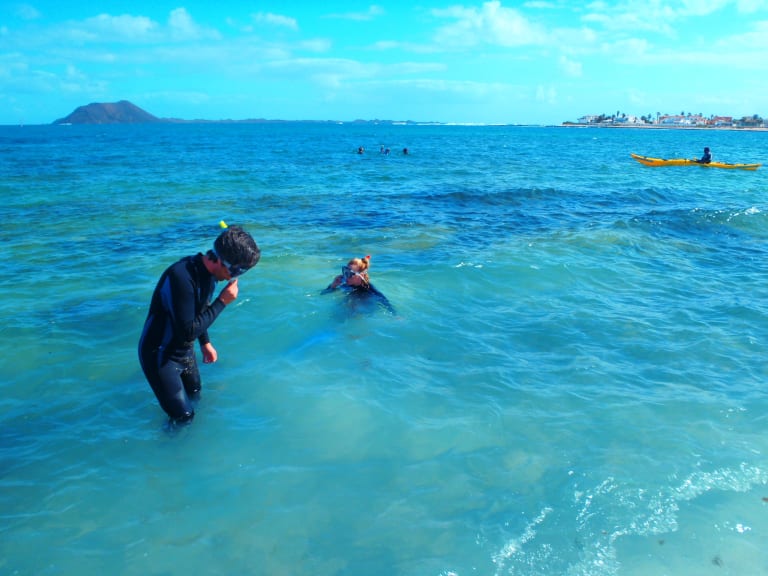
Morro Jable is a town in the south of Fuerteventura with a large influx of tourists and where there are plenty of companies offering snorkelling equipment hire and snorkelling lessons for beginners.
In these waters you can see animals such as sea urchins, starfish, octopus and even moray eels. The best place to snorkel in this area are the cliffs next to the viewpoint of Morro Jable.
You can reach them from the beach, although, if you prefer to enjoy the full experience, you can also hire a boat trip to snorkel in deeper waters. This way you will have the chance to see larger animals in uncrowded waters.
7. Snorkel in the natural lagoon of La Concha Beach

No, I'm not talking about San Sebastian, but La Concha beach in El Cotillo. El Cotillo is home to some of the best beaches on the island, and I particularly recommend this one for snorkelling.
La Concha beach is protected by a reef of volcanic rock and, depending on the rise and fall of the tide, you will see natural shallow lagoons forming on the coast , ideal for snorkelling, both for children and adults.
Ideally, arrive early in the morning and you may have the chance to see cuttlefish, goldfish and even octopus.
Although you may be able to find companies offering sporting goods for hire, it is best to arrive here with your own snorkelling goggles and snorkel.
Why snorkel in Fuerteventura?
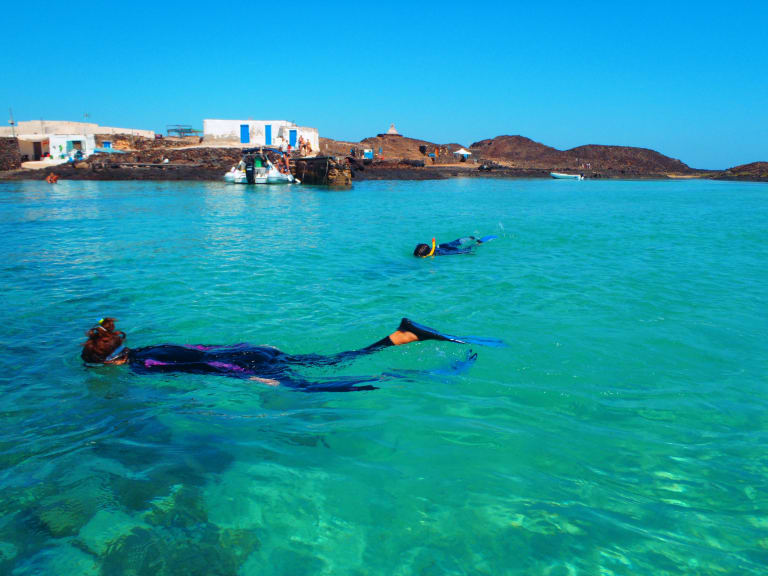
Fuerteventura is a snorkeller's paradise and you'll soon know why. Apart from its privileged climate, with temperatures that allow you to dive in the water all year round, and the clarity of its waters, which allow you to see the marine flora and fauna even if you are at a great distance, the most remarkable thing about Fuerteventura is its richness and diversity.
In Fuerteventura you can see around 400 species of aquatic life, including crabs, sea spiders, starfish and sea cucumbers, but also rays, tuna and a long etcetera.
In addition, its geological antiquity and volcanic past means that you can also see underwater volcanic landscapes, coral reefs and deep drop-offs. A true underwater paradise.
Snorkelling, a sport that doesn't require a lot of equipment
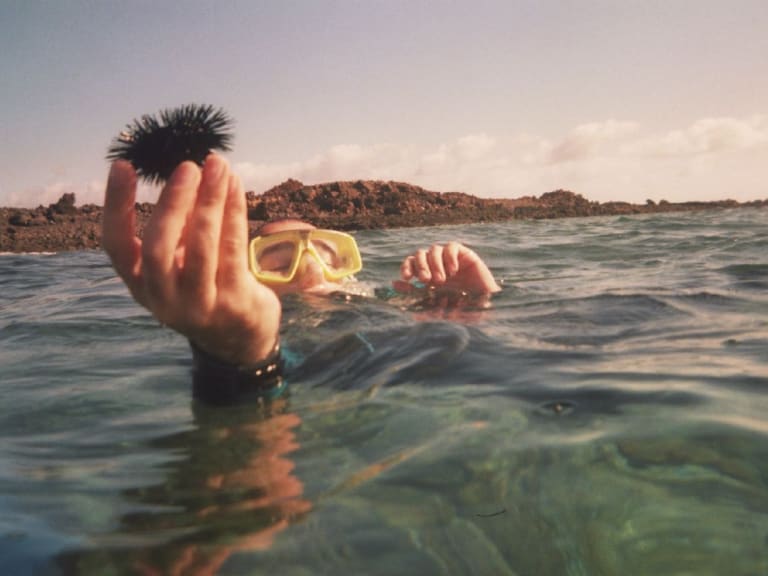
Snorkelling has become very popular on beaches all over the world in recent years. Snorkelling is basically diving underwater to observe marine life.
To snorkel, all you need is a pair of diving goggles and a snorkel, which allows you to stay as long as you want with your head underwater. Depending on where you'll be snorkelling, you may want to add fins to your attire and, if you're in very cold water, you may also want to wear a wetsuit.
Fortunately, Fuerteventura's average annual temperature is around 22⁰C, so you won't normally need any special equipment. In addition, the clarity of its waters, which, in many places, allow visibility down to a depth of 30 metres, make it a perfect place for snorkelling.
Having said all this, the last thing you need to go diving and enjoy this wonderful sport and its views of the seabed is an underwater camera or a watertight plastic case for your mobile phone.
Is it your first time snorkelling? I'll guide you
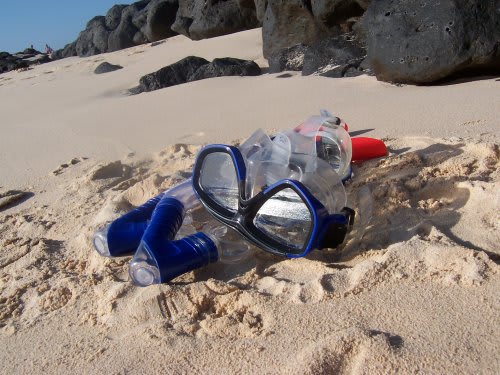
If this is the first time you do this sport, you should know that you need to know how to swim very well and learn to breathe through the snorkel, otherwise you could swallow water.
My recommendation is that, the first few times, you do it accompanied by someone more experienced, although this does not necessarily have to be a monitor, and that, above all, you do it in shallow water.
If you still don't feel safe trying it alone, don't force yourself! There are many places on the island where you can find schools that offer courses for beginners with an instructor who will teach you how to snorkel safely.
They will also give you advice on how to take care of the seabed so that your dive in these waters does not pose a danger to any species.
Tips for snorkelling
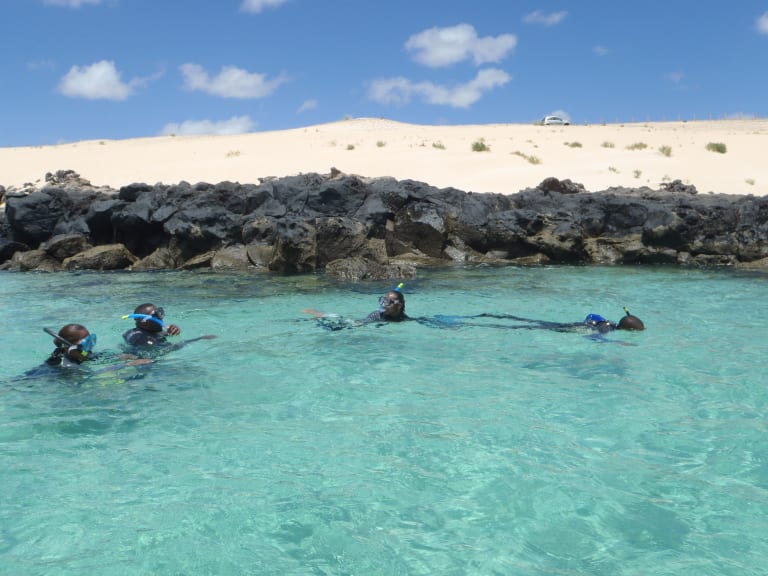
Whether you are an experienced snorkeller or a first time diver, it is important that you check the weather forecast for the area where you plan to snorkel before your d ive. Be aware that an unexpected storm or storm surge can cause dangerous currents - don't gamble!
It is important that you try to touch the seafloor as little as possible, as this will help protect the seafloor and its flora and fauna. Also, try not to disturb the marine species and, above all, don't touch the fish or feed them!
Although there are many other great activities to do with children in Fuerteventura , snorkelling is also perfectly compatible and many of them love it. Just keep in mind that caution is always the most important thing! So, it never hurts for children to wear a life jacket, even in shallow water.















